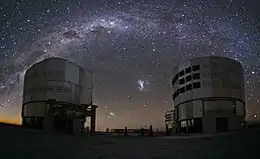Gamma Volantis
Gamma Volantis, Latinized from γ Volantis, is a wide binary star[5] system in the southern constellation of Volans. Based upon parallax measurements, it is approximately 133 light years from Earth. It is bright enough to be seen with the naked eye and can be found around 9° to the east-southeast of the Large Magellanic Cloud.[13]

| |
| Observation data Epoch J2000.0 Equinox J2000.0 | |
|---|---|
| Constellation | Volans |
| γ1 Vol | |
| Right ascension | 07h 08m 42.3703s[1] |
| Declination | −70° 29′ 49.527″[1] |
| Apparent magnitude (V) | 5.704[2] |
| γ2 Vol | |
| Right ascension | 07h 08m 44.8657s[3] |
| Declination | −70° 29′ 56.149″[3] |
| Apparent magnitude (V) | 3.62[4] |
| Characteristics | |
| Spectral type | F2V + K0III[5] |
| Astrometry | |
| γ1 Vol | |
| Radial velocity (Rv) | −3[6] km/s |
| Proper motion (μ) | RA: 11.069(437)[1] mas/yr Dec.: 107.302(577)[1] mas/yr |
| Parallax (π) | 22.7501 ± 0.4619[1] mas |
| Distance | 143 ± 3 ly (44.0 ± 0.9 pc) |
| Absolute magnitude (MV) | 2.51[7] |
| γ2 Vol | |
| Radial velocity (Rv) | +2.8[6] km/s |
| Proper motion (μ) | RA: 23.620(154)[3] mas/yr Dec.: 108.653(170)[3] mas/yr |
| Parallax (π) | 24.4775 ± 0.1130[3] mas |
| Distance | 133.2 ± 0.6 ly (40.9 ± 0.2 pc) |
| Details | |
| γ1 Vol | |
| Mass | 1.69[8] M☉ |
| Surface gravity (log g) | 2.71[8] cgs |
| Temperature | 6,541[7] K |
| Metallicity [Fe/H] | +0.12[2] dex |
| Rotational velocity (v sin i) | 4.4±0.2[7] km/s |
| Age | 1.4[2] Gyr |
| γ2 Vol | |
| Luminosity | 60[9] L☉ |
| Surface gravity (log g) | 2.7±0.1[10] cgs |
| Temperature | 4,866±34[10] K |
| Metallicity [Fe/H] | −0.01±0.03[10] dex |
| Other designations | |
| γ1 Vol: HD 55864, HIP 34473, HR 2735, SAO 256373[11] | |
| γ2 Vol: HD 55865, HIP 34481, HR 2736, SAO 256374[12] | |
| Database references | |
| SIMBAD | γ1 Vol |
| γ2 Vol | |

The brighter component, designated γ2 Volantis, is an orange K-type giant star with a stellar classification of K0 III and an apparent magnitude of +3.62, making this the brightest star in the constellation. Its companion, γ1 Volantis, is an F-type main-sequence star of classification F2 V and an apparent magnitude of +5.70. As of 2002, the pair were at an angular separation of 14.1″ along a position angle of 296°. Their separation has decreased from 15.7″ in 1826.[14] The secondary is a source of X-ray emission with a luminosity of 8.3×1028 erg s−1.[15]
References
- Brown, A. G. A.; et al. (Gaia collaboration). "Gaia Early Data Release 3: Summary of the contents and survey properties". Astronomy & Astrophysics (in press). arXiv:2012.01533. doi:10.1051/0004-6361/202039657. S2CID 227254300. Gaia EDR3 record for this source at VizieR.
- Holmberg, J.; et al. (July 2009), "The Geneva-Copenhagen survey of the solar neighbourhood. III. Improved distances, ages, and kinematics", Astronomy and Astrophysics, 501 (3): 941–947, arXiv:0811.3982, Bibcode:2009A&A...501..941H, doi:10.1051/0004-6361/200811191.
- Brown, A. G. A.; et al. (Gaia collaboration). "Gaia Early Data Release 3: Summary of the contents and survey properties". Astronomy & Astrophysics (in press). arXiv:2012.01533. doi:10.1051/0004-6361/202039657. S2CID 227254300. Gaia EDR3 record for this source at VizieR.
- Nicolet, B. (1978), "Photoelectric photometric Catalogue of homogeneous measurements in the UBV System", Astronomy and Astrophysics Supplement Series, 34: 1–49, Bibcode:1978A&AS...34....1N.
- Eggleton, P. P.; Tokovinin, A. A. (September 2008), "A catalogue of multiplicity among bright stellar systems", Monthly Notices of the Royal Astronomical Society, 389 (2): 869–879, arXiv:0806.2878, Bibcode:2008MNRAS.389..869E, doi:10.1111/j.1365-2966.2008.13596.x.
- Wilson, Ralph Elmer (1953), General Catalogue of Stellar Radial Velocities, Washington: Carnegie Institution of Washington, Bibcode:1953GCRV..C......0W.
- Ammler-von Eiff, M.; Reiners, A. (June 2012), "New measurements of rotation and differential rotation in A-F stars: are there two populations of differentially rotating stars?", Astronomy & Astrophysics, 542: 31, arXiv:1204.2459, Bibcode:2012A&A...542A.116A, doi:10.1051/0004-6361/201118724, A116.
- Casagrande, L.; et al. (June 2011), "New constraints on the chemical evolution of the solar neighbourhood and Galactic disc(s). Improved astrophysical parameters for the Geneva-Copenhagen Survey", Astronomy and Astrophysics, 530: A138, arXiv:1103.4651, Bibcode:2011A&A...530A.138C, doi:10.1051/0004-6361/201016276.
- McDonald, I.; et al. (2012), "Fundamental Parameters and Infrared Excesses of Hipparcos Stars", Monthly Notices of the Royal Astronomical Society, 427 (1): 343–57, arXiv:1208.2037, Bibcode:2012MNRAS.427..343M, doi:10.1111/j.1365-2966.2012.21873.x.
- Alves, S.; et al. (April 2015), "Determination of the spectroscopic stellar parameters for 257 field giant stars", Monthly Notices of the Royal Astronomical Society, 448 (3): 2749–2765, arXiv:1503.02556, Bibcode:2015MNRAS.448.2749A, doi:10.1093/mnras/stv189.
- "gam01 Vol -- Star", SIMBAD Astronomical Database, Centre de Données astronomiques de Strasbourg, retrieved 2016-09-03.
- "gam02 Vol". SIMBAD. Centre de données astronomiques de Strasbourg. Retrieved 2016-09-03.
- Bakich, Michael E. (2010), 1,001 Celestial Wonders to See Before You Die: The Best Sky Objects for Star Gazers, The Patrick Moore Practical Astronomy Series, Springer Science & Business Media, p. 13, ISBN 1441917772.
- Mason, B. D.; et al. (2014), The Washington Visual Double Star Catalog, Bibcode:2001AJ....122.3466M, doi:10.1086/323920, retrieved 2016-09-04
- Pizzolato, N.; et al. (September 2000), "Evolution of X-ray activity of 1-3 Msun late-type stars in early post-main-sequence phases", Astronomy and Astrophysics, 361: 614–628, Bibcode:2000A&A...361..614P.
External links
- Kaler, James B., "Gamma Volantis", Stars, University of Illinois, retrieved 2016-09-04.